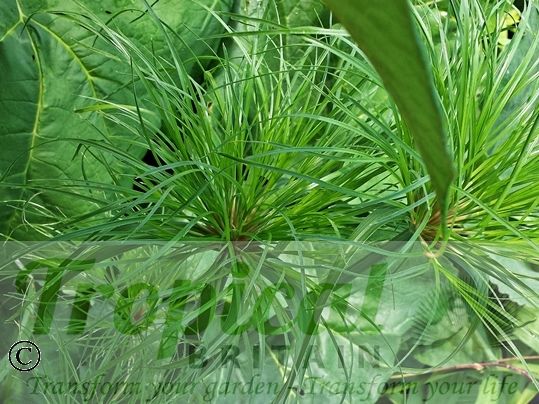Cyperus papyrus
Cyperus papyrus, the Egyptian Papyrus, although often used as a landscaping plant in many other parts of the world, is still relatively uncommon in the UK. The troublesome reality that it requires attention to get it through a typical British winter has no doubt contributed somewhat to this.
The relevant question then is: is it worth the effort?
The answer, of course, is subjective but looking at a large clump of this tall noble reed with its elegant terminal tufts is, for me, nothing short of a transcendent experience, instantly transporting me somewhere else, somewhere magical, mythical, to another time, another place... Depictions in Egyptian heiroglyphics seem to do it it no real justice other than as a reminder that I'm not the first to admire and appreciate it... How is it that a mere bog plant, a humble sedge, can be so uplifting, so elevating in appearance? There are perhaps only a few plants that have this effect, a shortlist of plant VIPs, where the associations, both historic and symbolic and the actual form itself seems to combine in one redolent heady mix. Nelumbo nucifera, the Sacred Lotus, is another plant that comes to mind... yet the Papyrus seems to achieve much the same effect with no breath-takingly beautiful flower. Just a tall slender stem and a large terminal bract that grows more and more elegant as it is develops, creating one perfect architectural form... or rather, a whole clump of them.
So what is the effort then? to survive the worst that Blighty can throw at it? What further hardship for the poor beleagured British gardener with so many seasonal tasks already demanding so much precious time? Well, you will need to take some root divisions, pot them up and keep them warm over winter... That's it... that's all. Replant in spring and watch them grow... daily, almost visibly... transforming your pond or boggy patch into a special place, a magical place...
Plus you get to make your own paper...
Is it worth it?
...for a few quid?
Probably...
Additional Information
| Order | Poales |
|---|---|
| Family | Cyperaceae |
| Synonyms | Chlorocyperus papyrus, Cyperus antiquorum, Cyperus antiquorum var. palaestinae, Cyperus elapsus, Cyperus panormitanus, Cyperus papyraceus, Cyperus papyrus subsp. antiquorum, Cyperus papyrus var. antiquorum, Cyperus papyrus subsp. antiquorum, Cyperus papyrus subsp. hadidii, Cyperus papyrus subsp. niliacus, Cyperus papyrus var. niliacus, Cyperus papyrus var. palaestinae, Cyperus papyrus subsp. papyrus, Cyperus papyrus subsp. siculus, Cyperus papyrus subsp. siculus, Cyperus papyrus subsp. ugandensis, Cyperus siculus, Cyperus syriacus, Cyperus ugandensis, Papyrus antiquorum, Papyrus domesticus, Papyrus mossambicensis, Papyrus siculus |
| Geographical Origin | Africa |
| Cultivation | Full sun or partial shade. Prefers moist soil: can be an aquatic or water marginal or grown in a damp spot. A warm shallow pond in a courtyard is ideal |
| Eventual Height | 2.5m |
| Eventual Spread | Spreading to a large area by vigorous rhizomes: it is a large plant and requires a large space |
| Hardiness | Not fully hardy except in southern and southwest coastal areas and urban London courtyards or sheltered gardens. Apply a thick mulch to try it as a herbaceous perennial or take root divisions and pot them up in containers and bring into a frost-free area |

Free DELIVERY
ON ALL ORDERS OVER £99THIS OFFER IS VALID ON ALL OUR STORE ITEMS.












